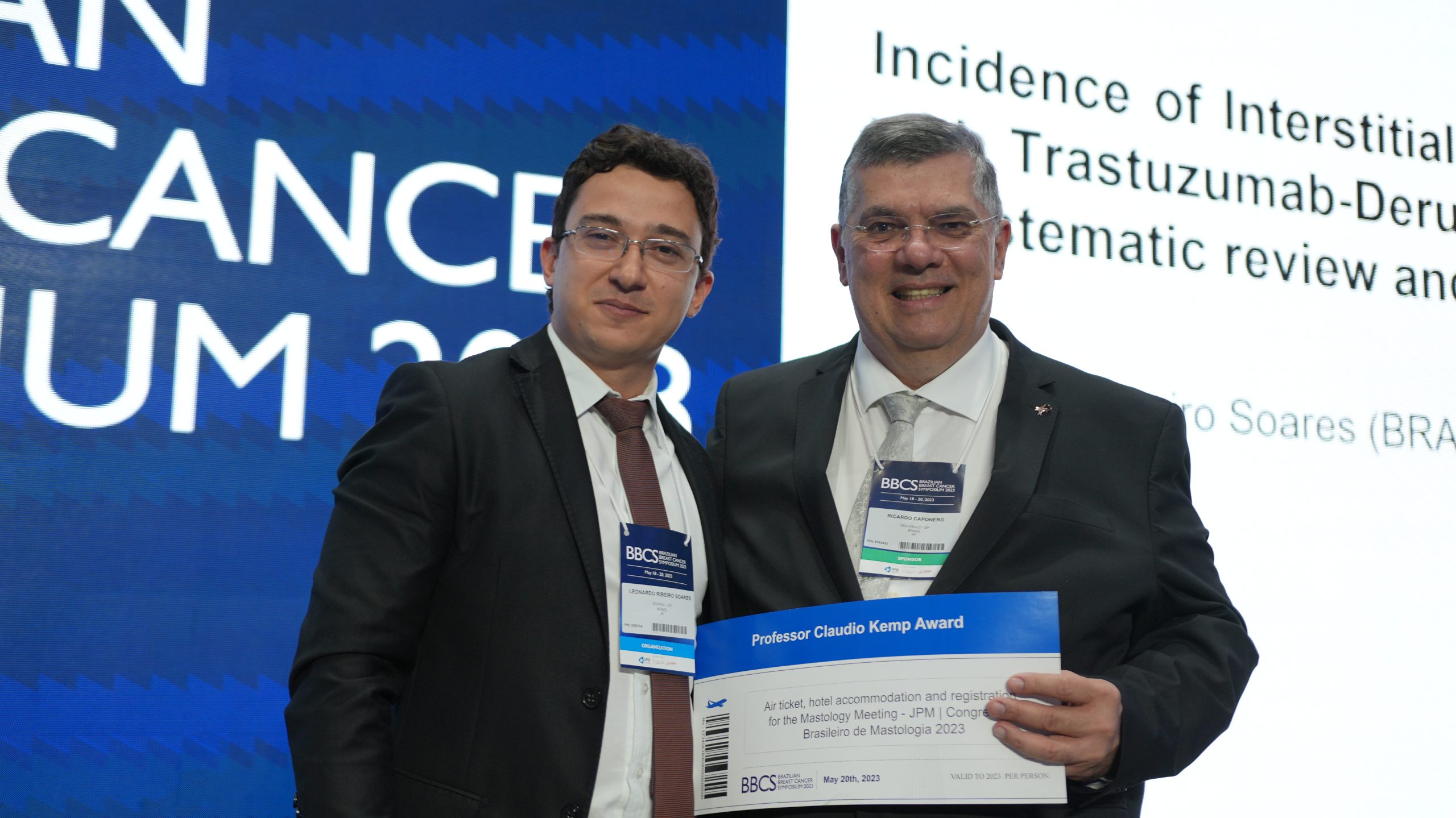Professor


O Dr. Claudio Kemp era conhecido não só por seu admirável currículo, mas também por sua forma de tratar as pessoas... descontraído, descontraído... trazia um toque de leveza para colorir a seriedade da profissão. Ele costumava ensinar não apenas habilidades técnicas, mas também cuidados humanos.
Sua maneira particular de interagir fez com que as pessoas gravitassem em torno dele, especialmente seus alunos!
Apaixonado por imagem da mama, ele influenciou muitas gerações na academia!
Espero que o jovem pesquisador possa usufruir de seu legado e crescer profissionalmente com humildade e competência, seguindo seus passos. Simone Elias (uma de suas alunas e depois colega) disse certa vez: 'ele olhava a vida com olhos de sábio, o futuro com olhos de criança e o mundo com olhos de artista'.
Mariza, Ana e Marta Kemp
O prémio Professor Claudio Kemp é dirigido a jovens investigadores, e atribuído ao investigador que apresentou o melhor artigo no BBCS – na categoria 'até 35 anos'. O prêmio concedido é passagem, hospedagem e inscrição para a Jornada Paulista de Mastologia do mesmo ano.

INCIDENCE OF INTERSTITIAL LUNG DISEASE AND CARDIOTOXICITY WITH TRASTUZUMAB-DERUXTECAN IN BREAST CANCER PATIENTS: A SYSTEMATIC REVIEW AND SINGLE-ARM META-ANALYSIS
Leonardo Ribeiro Soares¹, Victor Domingos Lisita Rosa¹, Maysa Vilbert², Jéssica Lopes de Oliveira³, Mariana Moreira de Deus¹, Ruffo Freitas-Junior¹
¹Federal University of Goiás|Goiânia|Goiás|Brazil
²Princess Margaret Cancer Centre, University Health Network, University of Toronto|Toronto|Ontário|Canadá
³Dona Íris Hospital and Maternity, Municipal Health Department|Goiânia|Goiás|Brazil
Objective: We performed a systematic review and meta-analysis to assess the incidence and severity of those adverse events (AE) in metastatic breast cancer (mBC) patients treated with Trastuzumab-Deruxtecan (T-DXd). Methodology: We comprehensively searched Pubmed, Cochrane, and Scopus databases for randomized clinical trials (RCT) and observational cohort studies, including mBC patients with HER2-low or -positive expression who have received at least one dose of T-DXd. The DESTINY-Breast02 study was also included after its presentation at the SABCS 2022. Our meta-analysis followed the Cochrane Reviews and PRISMA statement guidelines. The statistical analysis was performed using R software, and the results are presented as pooled analysis in forest plots. Results: We included nine studies: three phase III RCTs, three phase II and two phase I non-RCTs, and one retrospective cohort comprising 1,443 patients with a mean follow-up of 14.9 months. The median age of our population ranged from 53 to 59 years. Most were non-Asian (40.5%) and presented with hormone-receptor positive mBC (66.8%). In a pooled analysis, the incidence of ILD was 13.0% (179 patients; 95%CI 11.0 to 13.0). Patients enrolled in phase III clinical trials had an ILD rate of 12.0%, while the observational cohort reported a numerically higher rate of 18.0%. Most ILD cases, 84.9% (152 patients), were mild (grade 1 or 2). Grade 3 or 4 AE were reported in 13 patients (7,3%), and grade 5 in 14 patients (7,8%). We assessed cardiotoxicity by the reduction of left ventricular ejection fraction (LVEF) compared to baseline measures. Decreased LVEF was seen in 3.6% (95%CI 3.0 – 5.0%), and most patients were asymptomatic. Eleven patients developed prolonged QT interval, and four had left ventricular dysfunction and cardiac failure. Conclusion: Our meta-analysis reinforces the importance of close vigilance for pulmonary and cardiac toxicities in mBC patients on treatment with T-DXd. Early detection and management by a multidisciplinary team following the most recent guidelines may improve the patient outcomes.
Keywords: Breast cancer, Metastatic breast cancer, Interstitial lung disease, Cardiotoxicity, Trastuzumab deruxtecan.
INVESTIGATION OF CIRCULATING-TUMOR DNA (ctDNA) IN PATIENTS WITH NON-METASTATIC TRIPLE-NEGATIVE BREAST CANCER (TNBC) SUBMITTED TO NEOADJUVANT CHEMOTHERAPY
Rafael Canfield Brianese1, Giovana Tardin Torrezan1, Marina de Brot Andrade2, Vladmir Claudio Cordeiro de Lima3, Solange Moraes Sanches3, Maria Nirvana da Cruz Formiga4, Fabiana Baroni Alves Makdissi5, Dirce Maria Carraro1
1Laboratory of Clinical and Functional Genomics – A. C. Camargo Cancer Center, São Paulo (SP) – Brazil
2Pathology Department – A.C. Camargo Cancer Center, São Paulo (SP) – Brazil
3Clinical Oncology Department – A.C. Camargo Cancer Center, São Paulo (SP) – Brazil
4Oncogenetics and Clinical Oncology Department – A.C. Camargo Cancer Center, São Paulo – Brazil
5Breast Surgery Department – A. C. Camargo Cancer Center, São Paulo (SP) – Brazil
Objective: Loss-of-function germline mutation in BRCA1 increases breast cancer risk, especially the TNBC subtype. BRCA1 impairment may confer benefit from treatment with DNA damage-inducing drugs and PARP1 inhibitors. Patients who respond to neoadjuvant chemotherapy tend to have good outcomes. Our aim is to characterize the resistance to chemotherapy in patients with germline-characterized TNBC by investigating somatic mutations in ctDNA.
Methodology: Germline genetic testing using cancer-predisposing gene panels (26-126 genes) for classifying TNBC as Hereditary or Sporadic. Somatic mutation identification in tumor (409 cancer-related gene panel) and screening of ctDNA in plasma samples during treatment.
Results: We enrolled 96 TNBC patients of which 88 were tested for germline variants: 23% (20/88) of cases were Hereditary – BRCA1 (16%), BRCA2 (4%), PALB2 (1%), RAD51D (1%) and TP53 (1%). Tumor mutation burden (TMB) analysis (43 cases) showed that 11.6% had high and 89.4% low TMB, not associated with Hereditary status. We found, on average, 3 somatic variants per tumor (range 1-7) and used them as tumor marks for screening ctDNA in plasma. Somatic mutations in TP53 were identified in most tumors (71%). In ctDNA before treatment, detection of at least one tumor mutation was observed in 24 out of 30 patients (80%) and no association was observed regarding Hereditary status and TMB score. Although ctDNA was not associated to the residual cancer burden (RCB) score, ctDNA- positive patients were associated with clinical progression, either at baseline and during monitoring (post-neoadjuvant chemo) and ctDNA identification anticipated progression detected by imaging.
Conclusion: Hereditary tumors, markedly due to germline variants in BRCA1, are frequent in TNBC. Tumor-mark identification using gene panel and ctDNA screening in plasma samples provide valuable information regarding clinical progression of patients treated with pre-operative chemotherapy.
Keywords: hereditary tumor; triple-negative breast cancer; ctDNA; liquid biopsy